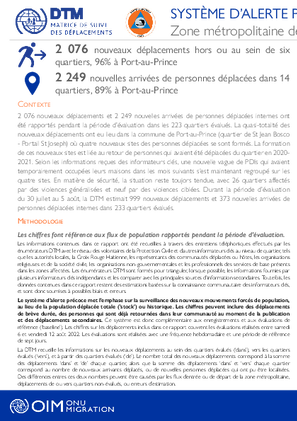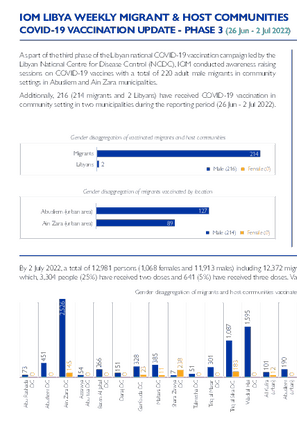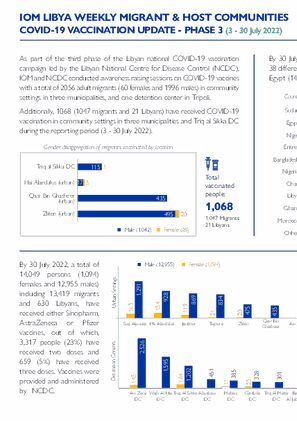-
Countries
-
Data and Analysis
-
Special Focus
-
Crisis Responses

Contact
dtmhaiti@iom.int
Language
English
Location
Haiti
Period Covered
Aug 06 2022
Aug 12 2022
Activity
- Event Tracking
2 076 nouveaux déplacements et 2 249 nouvelles arrivées de personnes déplacées internes ont été rapportés pendant la période d’évaluation dans les 223 quartiers évalués. La quasi-totalité des nouveuax déplacements ont eu lieu dans la commune de Port-au-Prince (quartier de St Jean Bosco - Portail St Joseph) où quatre nouveaux sites des personnes déplacées se sont formés. La formation de ces nouveaux sites est liée au retour de personnes qui avaient été déplacées du quartier en 2020-2021. Selon les informations reçues des informateurs clés, une nouvelle vague de PDIs qui avaient temporairement occupées leurs maisons dans les mois suivants s'est maintenant regroupé sur les quatre sites. En matière de sécurité, la situation reste toujors tendue, avec 26 quartiers affectés par des violences généralisées et neuf par des violences ciblées. Durant la période d’évaluation du 30 juillet au 5 août, la DTM estimait 999 nouveaux déplacements et 373 nouvelles arrivées de personnes déplacées internes dans 233 quartiers évalués.
During the reporting period (03 to 09 August 2022), a total of 72 movements were recorded - 50 arrivals (2,098 individuals), 11 departures (320 individuals), 9 returns (2,533 individuals), and 2 transits (518 individuals). The largest arrival movements were recorded in Quissanga (655 individuals), Ancuabe (315 individuals), Macomia (296 individuals), Muidumbe (217 individuals) and Cidade de Pemba (216 individuals). The largest departure movements were recorded in Nangade (296 individuals). The largest return movement was observed in Quissanga (2,260 individuals). The largest transit movement was observed in Mueda (518 individuals). Of the total population, 14 per cent of mobile groups were displaced for the first time, and 86 percent of reported individuals have been displaced more than once prior to this movement.
Contact
DTM Sudan, DTMSudan@iom.int
Location
Sudan
Activity
- Mobility Tracking
- Baseline Assessment
Period Covered
Dec 10 2021 -Feb 04 2022
A baseline assessment is a sub-component of mobility tracking. It aims to collect data on IDP, migrant or returnee population presence in a defined administrative area of the country.
Population Groups
Survey Methodology
Unit of Analysis Or Observation
Type of Survey or Assessment
Keywords
Geographical Scope
Administrative boundaries with available data
The current dataset covers the following administrative boundaries

Contact
DTM Libya, DTMLibya@iom.int
Language
English
Location
Libya
Period Covered
Jun 26 2022
Jul 02 2022
Activity
- Other
As part of the third phase of the Libyan national COVID-19 vaccination campaign led by the Libyan National Centre for Disease Control (NCDC), IOM conducted awareness raising sessions on COVID-19 vaccines with a total of 220 adult male migrants in community settings in Abusliem and Ain Zara municipalities. Additionally, 216 (214 migrants and 2 Libyans) have received COVID-19 vaccination in community setting in two municipalities during the reporting period (26 Jun - 2 Jul 2022).
Contact
DTM Sudan, DTMSudan@iom.int
Location
Sudan
Activity
- Mobility Tracking
- Baseline Assessment
Period Covered
Dec 10 2021 -Feb 08 2022
A baseline assessment is a sub-component of mobility tracking. It aims to collect data on IDP, migrant or returnee population presence in a defined administrative area of the country.
Population Groups
Survey Methodology
Unit of Analysis Or Observation
Type of Survey or Assessment
Keywords
Geographical Scope
Administrative boundaries with available data
The current dataset covers the following administrative boundaries

Contact
DTM Libya, DTMLibya@iom.int
Language
English
Location
Libya
Period Covered
Jul 03 2022
Jul 31 2022
Activity
- Other
As part of the third phase of the Libyan national COVID-19 vaccination campaign led by the Libyan National Centre for Disease Control (NCDC), IOM and NCDC conducted awareness raising sessions on COVID-19 vaccines with a total of 2056 adult migrants (60 females and 1996 males) in community settings in three municipalities, and one detention center in Tripoli. Additionally, 1068 (1047 migrants and 21 Libyans) have received COVID-19 vaccination in community settings in three municipalities and Triq al Sikka DC during the reporting period (3 - 30 July 2022).
Contact
DTM Sudan, DTMSudan@iom.int
Location
Sudan
Activity
- Mobility Tracking
- Baseline Assessment
Period Covered
Dec 10 2021 -Feb 08 2022
A baseline assessment is a sub-component of mobility tracking. It aims to collect data on IDP, migrant or returnee population presence in a defined administrative area of the country.
Population Groups
Survey Methodology
Unit of Analysis Or Observation
Type of Survey or Assessment
Keywords
Geographical Scope
Administrative boundaries with available data
The current dataset covers the following administrative boundaries

Contact
DTM Libya, DTMLibya@iom.int
Language
English
Location
Libya
Period Covered
Jul 31 2022
Aug 06 2022
Activity
- Other
As part of the third phase of the Libyan national COVID-19 vaccination campaign led by the Libyan National Centre for Disease Control (NCDC), IOM and NCDC conducted awareness raising sessions on COVID-19 vaccines with a total of 3,819 adult migrants (178 females and 3,641 males) in community settings in five municipalities. Additionally, 1,704 (1,690 migrants and 14 Libyans) have received COVID-19 vaccination in community settings in three municipalities and Triq al Sikka DC during the reporting period (31 Jul - 6 Aug 2022)

Contact
DTM Libya, DTMLibya@iom.int
Language
English
Location
Libya
Period Covered
Aug 07 2022
Aug 13 2022
Activity
- Other
As part of the third phase of the Libyan national COVID-19 vaccination campaign led by the Libyan National Centre for Disease Control (NCDC), IOM and NCDC conducted awareness raising sessions on COVID-19 vaccines with a total of 634 adult migrants in community settings in Hai Alandalus, Abusleim, and janzour municipalities. Additionally, 440 (437 migrants and 3 Libyans) have received COVID-19 vaccination in community settings in three municipalities and Triq al Matar DC during the reporting period (7 - 13 Aug 2022).
Flow Monitoring is a component of DTM and it is used to track population movements inside a country, within a region or across regions. The dataset includes:
- monthly and daily figures on arrivals by sea and by land to Europe (Bulgaria, Cyprus, Greece, Italy, Malta, Spain)
- monthly and daily figures on transits along the Western Balkan region (Albania, Bosnia and Herzegovina, Croatia, Montenegro, North Macedonia, Romania, Slovenia, Serbia, Kosovo*)
- figures on reported country and areas of origin of arrivals and transits
- figures on reported migrant presence in reception centers.
Population Groups
Survey Methodology
Unit of Analysis Or Observation
Type of Survey or Assessment

